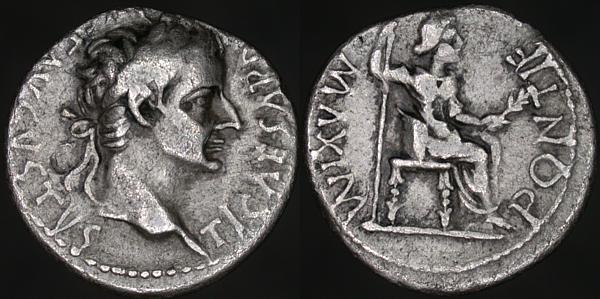Friday’s post on religious images involved the “Render Unto Caesar” discourse from Matthew 22:15-22:
Then the Pharisees went out and laid plans to trap Him in His words. They sent their disciples to Him along with the Herodians. “Teacher,” they said, “we know that you are a man of integrity and that you teach the way of God in accordance with the truth. You aren’t swayed by others, because you pay no attention to who they are. Tell us then, what is Your opinion? Is it right to pay the imperial tax to Caesar or not?”But Jesus, knowing their evil intent, said, “You hypocrites, why are you trying to trap Me? Show Me the coin used for paying the tax.” They brought Him a denarius, and He asked them, “Whose image is this? And whose inscription?”“Caesar’s,” they replied. Then He said to them, “So give back to Caesar what is Caesar’s, and to God what is God’s.” When they heard this, they were amazed. So they left Him and went away.
The timing of the post was unintentionally perfect. First, a copy of Abp. Chaput’s book, Render Unto Caesar (which I’d forgotten I’d requested), came in the mail the next day. And second, this passage was the Gospel reading on Sunday. Fr. Kleinmann’s homily on this passage made three points worth highlighting.
Jewish politics under Roman rule could be complex. The major question was whether, and how much, to work with the pagan Romans. In this regard, the Pharisees and Herodians were enemies, because the Herodians had completely sold out, while the Pharisees sought to assuage the Romans, while creating ever-stricter internal religious rules. In other words, it’s likely that the Pharisees and Herodians had different motives in wanting to ask Jesus this question, although they were united in wanting to trip They probably also were hoping for different answers.
In a nutshell, here’s why it was a trap:
- If Jesus denounced the payment of the tax, He’d be guilty of a capital crime.
- If Jesus supported the payment of the tax, He’d appear to betray His people. The Romans were unpopular, often brutal, rulers. To endorse them would appear to betray the Jewish people, particularly since many of them thought of Jesus still as Messiah in a political sense, of One who lead an army to overthrow the Romans. Worse, the Roman Emperor was making blasphemous claims about claiming to be God. Endorsing him would appear to be endorsing paganism.
In fact, this is one of the crimes He’s accused of (Luke 23:2). But Jesus’ Death was about His claim to be the Son of God, and about His Atonement for the sins of mankind, not making a tax protest.
Either way He answered, it seemed that Jesus’ ministry would quickly get sidetracked into political feuds about tax payment and Roman public policy, even assuming He wasn’t executed for it. Jesus’ answer here is brilliant, as we’ll see.
As a numismatist reader noticed, the coin I used in Friday’s post was of Antonius Pius, who was born well after the death of Christ. Most likely, the coin Jesus was talking about was this one:
The inscription on the front of the coin means “Caesar Augustus Tiberius, son of the Divine Augustus.” In other words, it’s Tiberius blasphemously claiming to be Son of God. And the coin becomes a tool for the true Son of God, Jesus Christ, to teach us about His Father, and how we can become sons and daughters of God.
It’s interesting to see how Jesus handles this coin, given that background. Archbishop Chaput has this to say about Jesus’ answer, on page 204 of Render Unto Caesar (emphasis added):
It’s a clever answer. It’s also profound. Jesus does three vital things here. First, he acknowledges that Caesar has rights; that a difference does exist between the things that belong to God and the things that belong to Caesar. But second, he desacralizes – in effect, he demotes – Caesar by suggesting that Caesar has no rights over those things that belong to God. Only God is God, which means Caesar is not God. Caesar’s authority has limits. And third, Jesus stays silent about what exactly belongs to either one. Figuring that out belongs to us.
So Jesus is debunking the notion that Tiberius Caesar is the son of the Divine. He’s flatly rejecting idolatry But, to get back to the point of Friday’s post, He doesn’t do it through some knee-jerk iconoclasm, but through showing us who Is and isn’t God. (There’s also a lot there about the appropriate roles of Church and State, but I’ll do a post on that at a later date, after I’ve had a chance to read all of Chaput’s book.)
This is a point I’d never noticed. In Matthew 22:18-20, there’s a crucial detail:
But Jesus, knowing their evil intent, said, “You hypocrites, why are you trying to trap Me? Show Me the coin used for paying the tax.” They brought Him a denarius, and He asked them, “Whose image is this? And whose inscription?”
UPDATE: I should have mentioned this earlier. I’m going to be talking about Friday’s post on “graven images” tomorrow morning at 8:50 Eastern on the Son Rise Morning Show. Feel free to listen in live online, or tune in the days to come to see if they re-air it. Thanks!



Looks like the coin says “High Priest” too…
Yes, it does. I’m pleased with your Latin skills.
Well, its an abbreviation for “Pontifex Maximus”, one of the titles of the chief priest of the Roman state religion, which the emperors had glommed together with a number of other offices invented in the good old republican days.
True. Technically, it says “greatest bridge-maker,” not “high priest,” but it meant “high priest.”
And of course, just as Jesus Christanized the coin, we Christanized the title.
Your post is quite solid. This is the historical context of the story that we need to hear to better understand the layers of meaning present. I do not mean to sound snarky….. but this is rather basic information about this gospel story that is often used as the basis for the homily. Does this information never come across in sermons or Bible studies in your parish? I am just surprised that it was the basis of this blog post.
Thanks Joe – good to know that three horrible years of Latin in High School weren’t wasted…
JESUS SAVES: There are some things that, although basic, bear repeating…
Rev. Hans,
Fair question. I don’t think that I knew (2) or (3). I did know that there were blasphemous claims by Caesar, and that some Roman coinage reflected this, but I didn’t know about the specific coin in Matthew 22 until Sunday.
You’re right that (1) was basic background. I wanted to make sure that anyone reading was familiar with what was going on, just in case. Otherwise, I figured that the rest of the post wouldn’t make sense.
God bless,
Joe
Of course, the best way out of this dilemma is to make sure you have NOTHING that belongs to Caesar.
One of the Teresas said this, I believe.
“The image of Caesar, which is money, to Caesar. And the image of God, which is man, to God…”
– Rev Fr Cornelius Lapide